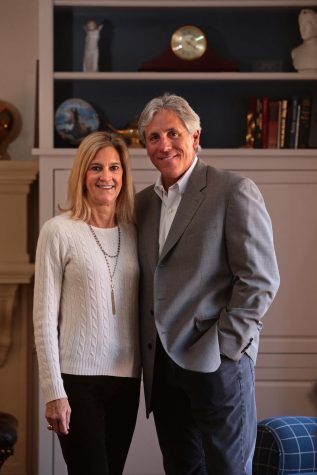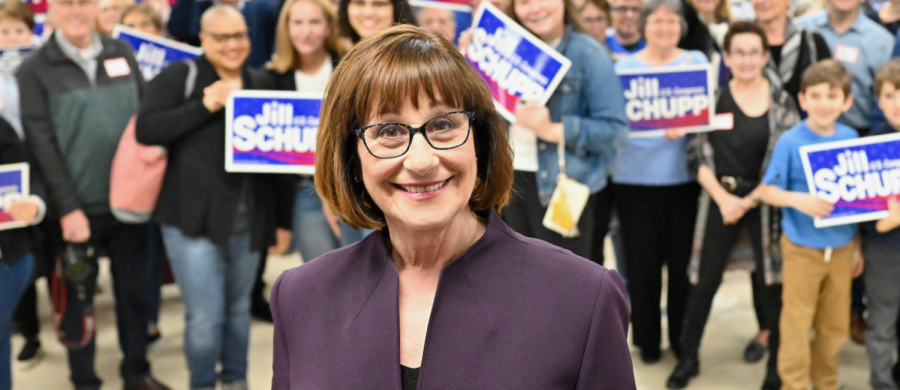Jill Schupp surrounded by a group of her supporters
Campaigning While Socially Distancing
As coronavirus makes it increasingly difficult to meet constituents in person, politicians must find another way to earn votes
The year of 2020 will be permanently memorialized for the COVID-19 pandemic, and in the shadows, the critical political response that determined the future of the pandemic’s path. Politics have been inextricably tied to the COVID-19 pandemic and proven a rigorous test to the strength of the current St. Louis local leadership. Both incumbents and challengers now have the unique opportunity to advocate for and prove the efficacy of their designed responses to the pandemic, and these proposed and established response methods could serve as an ultimate determining factor for who constituents mark on their ballot in the fall.
In proving their ability to listen to constituents, politicians seeking an elected official position have had to shift to virtual campaigning and face a new set of unprecedented challenges.
Ali O’Neil, the campaign manager for Jill Schupp’s bid for the 2nd District Representative in Congress, explained that virtual strategies normally used as one of many components of Schupp’s overall campaign are now being frontlined as the main strategy. Where Schupp’s campaign would previously have been attending public community events and executing a door-to-door strategy, the committee is now turning towards phone banking and text campaigns to spread awareness of Schupp’s campaign and to recruit volunteers.
O’Neil added that the campaign is utilizing communication programs to emulate in-person activities. “We’re also using tools like Zoom and other types of video conferencing tools to conduct our events like our meet-and-greets, our fundraisers, and also to train our volunteers,” said O’Neil.
Energy is also a necessary factor that O’Neil and Schupp try to incorporate in the campaign. “We’re having folks sign up to volunteer online and then actually conducting training sessions that try to mimic the same environment that you would get by going into a campaign office or volunteering with people or with your friends. We’re trying to keep that same atmosphere, but obviously just in a virtual capacity.”

Candidate for St. Louis County Executive, Mark Mantovani, similarly uses communication platforms to keep voter bases engaged amidst social distancing guidelines. “We’ve held some virtual sessions with prospective voters where I would speak and people could ask questions,” said Mantovani.
However, Mantovani highly prefers an in-person approach to relate to voters, finding that virtual alternatives are lacking in what would usually be a more personal level of communication and engagement. “It’s a challenge to communicate with undecided voters. People who are already committed to me or believe in me or are part of our past supporter network are always willing to jump on a Zoom call or have some kind of virtual engagement, but undecided folks are less inclined to participate. I think there’s also been a challenge to get people’s attention because we’ve all been preoccupied with the circumstances of our personal and family lives, and jobs and school.”
Both candidates view social media as a major platform to progress their campaign reaches and plan to maintain and increase focus on this type of outreach. “[Social media advertising] has been a trend in elections in recent years. There’s perhaps been a little more focus on it, but that’s not something we’ve ignored previously,” said Mantovani. His campaign plans to continue to maintain social media presence, viewing it as a critical tool as Schupp’s campaign does.
In addition to maintaining a social media presence, O’Neil says that Schupp’s campaign plans to continue to innovate new ways of virtually reaching constituents of different levels of online visibility. “The critical question is always how do we reach people who aren’t on social media, or how do you broaden your reach on social media? That’s the constant discussion and question that we’re having on the campaign. We have to reach voters and the second congressional district is vast and diverse in terms of geography. We need to be able to think and make sure that we are reaching people where they’re at.”
To accommodate constituents who lack a strong social media presence or do not have reliable technology, Schupp’s campaign has initiated efforts to key in to a variety of technology types, like tele-town halls where only phone access is needed.
“It’s important not just to put a link up and say oh here’s a way you can reach me, but to actively and proactively go out into the community and make it accessible for people in a variety of ways. Yes, more reliance on social media, but also thinking critically about how to expand our reach on social media,” said O’Neil.
O’Neil also stressed the importance of expressing Schupp’s personality through a digital route, in particular selfie-style videos that have a more relatable effect. “[For example], last week it was National Teacher Appreciation Day. We did a short video about that. We’ve done a photo of her going to see her mom while also social distancing [that we posted] on our Twitter page. A lot of people appreciated that,” said O’Neil.
“It’s important to incorporate those aspects into your message and your campaign strategy as well. Because Jill is a human, demonstrating her personality will ultimately be a nice thing that voters most resonate with and connect with.”
Fundraising is another challenge that campaigning politicians must adapt to for their campaigns. Mantovani detailed that, in the past, social gatherings have been crucial in raising a large amount of funds and advertising his campaign, but this method has now had to be moved virtually. “Outreach has been more telephonic and much more digital. We have a group of supporters from two years ago and they’ve been easy to contact electronically, but it’s not the same when you can’t have a meeting. You can’t shake hands. You can’t connect with people as much on a personal level,” said Mantovani.
Furthermore, another difficult element Mantovani mentioned is the shift in priorities, as financial situations grow more uncertain and donations are increasingly more directed towards resources.
As for voter turnout, Mantovani predicted that “I would think [voter turnout] would be smaller this time, but I don’t know how much. In some respects, the pandemic might make people more skittish about appearing, but I think it also has dramatized the importance of leadership. There actually might be a higher level of interest in local leadership than there would have been before, [although] I’d be surprised if that compensates,” predicted Mantovani.
“I think it won’t be as small as some people believe just because I think a lot of voters are more tuned into leadership and impact on our lives. People are concerned about who has the apparent authority and so there might be more sensitivity to ‘who’s in office.”
O’Neil believes that the COVID-19 pandemic will have a significant impact on the strategy towards how campaigns operate in later years. “I think it will revolutionize the way we think of some of these digital tools. A lot of them have been around for a couple of cycles, maybe for 5 to 10 years even. But there’s always a bit of hesitancy in campaigns; it’s very cyclical. There’s emphasis on door knocking and certain [established’ ways you reach voters. With some of those things being impossible to do this cycle, I think people are starting to think more strategically about digital tools and how they’re using these to reach out to voters,” said O’Neil.
Overall, campaigning during the pandemic has unexpectedly created a shift in a fairly traditional mold of operations, but Jill Schupp and Mark Mantovani’s campaigns have rapidly found methods of adapting. By utilizing online tools and developing a variety of approaches, political campaigns are still able to continue to reach constituents at a time when voters want to depend on their leadership more than ever.
